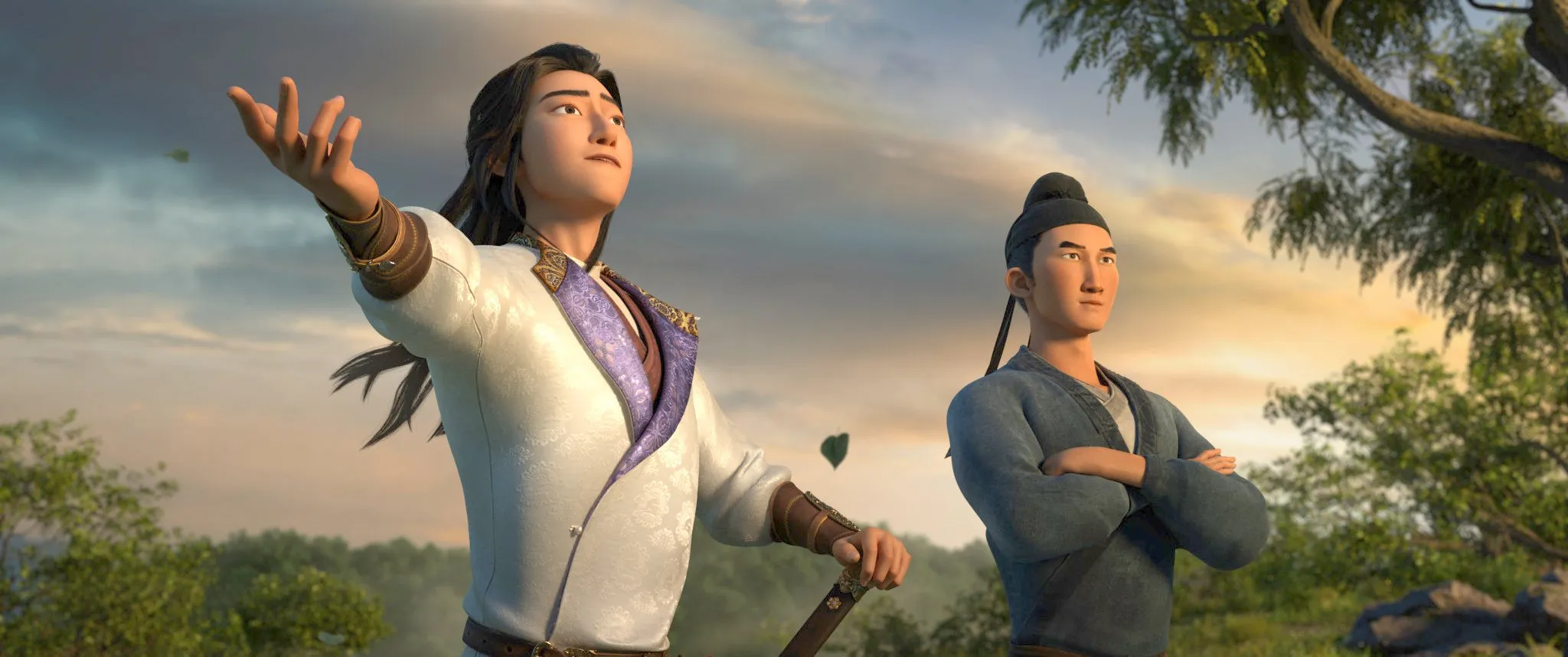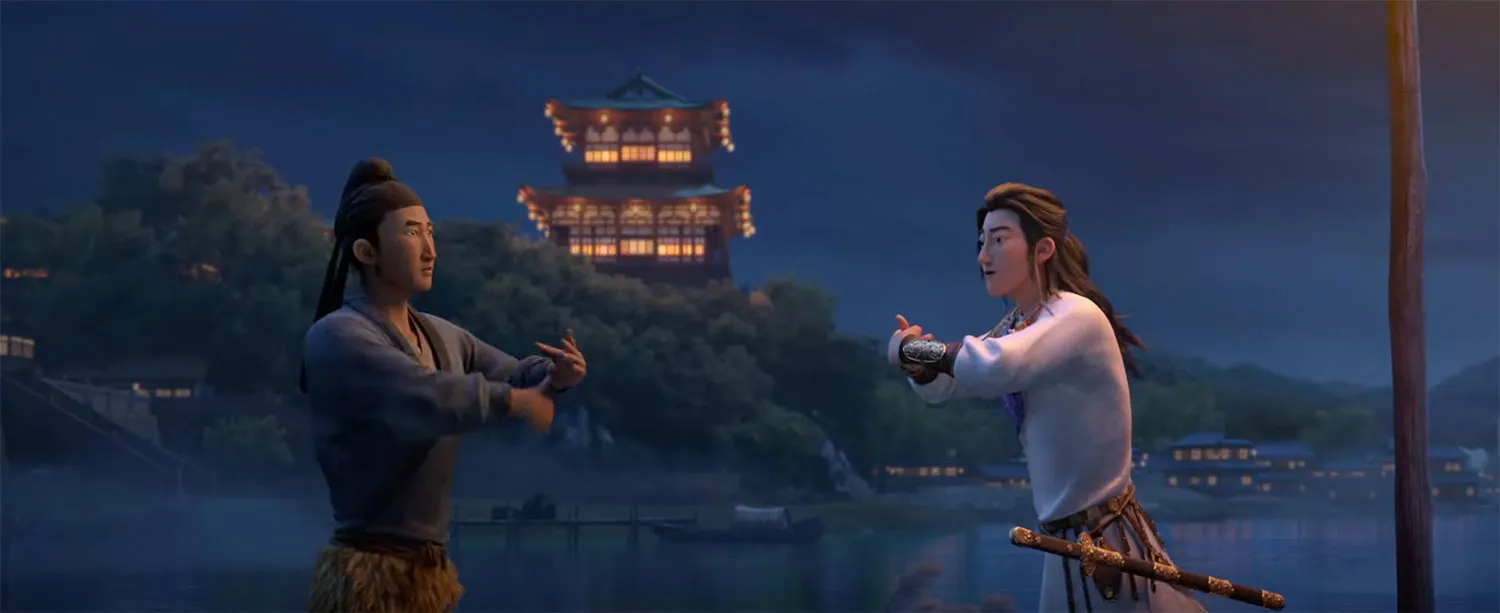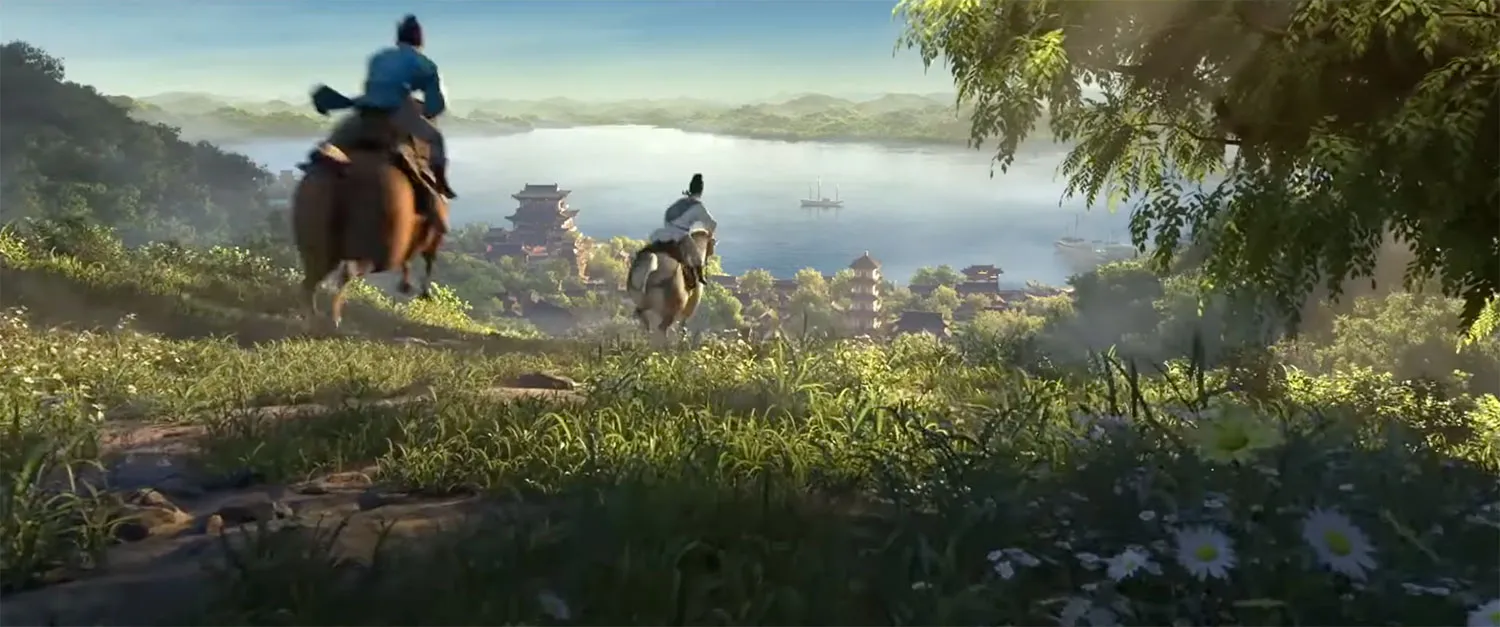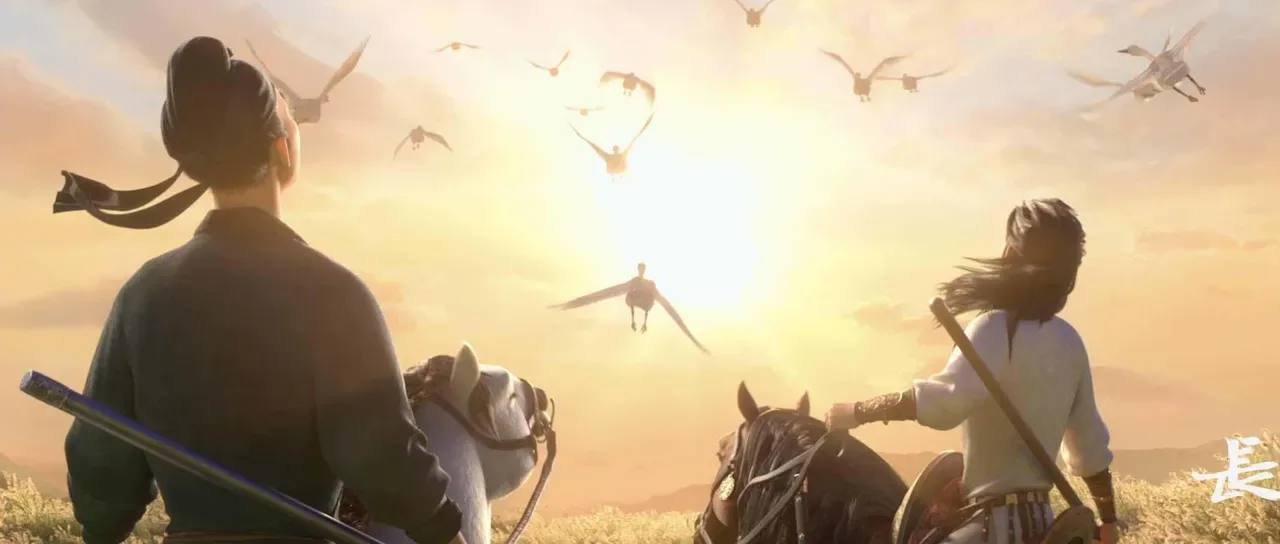“Chang’an” (or 30,000 Miles from Chang’an), the latest animated feature from Light Chaser Animation Studios, offers a sweeping historical drama set during the Tang Dynasty.
Spanning nearly three hours, the film blends political intrigue with lyrical artistry as it charts the intertwined lives of two prominent figures: the general and poet Gao Shi and the legendary poet Li Bai.
This film’s vast historical scope, including the backdrop of the Anshi Rebellion, provides a detailed portrait of an era defined by poetic innovation and military conflict.
The animation style sets a tone that balances between realism and artistic abstraction, using fine details to capture the grandeur of the Tang capital, Chang’an, while showcasing intricate battle sequences. The film’s visual storytelling draws from ancient Chinese artistic traditions, reflecting the cultural values of the time while bringing them to life through a modern cinematic lens.
The Interplay of History and Poetics: Narrative and Structure in Chang’an
The narrative structure of Chang’an is marked by a fluid movement between time periods, using flashbacks and Gao Shi’s reflective voice to anchor the audience within the events of the Tang Dynasty.
These narrative choices serve not only to explore the political and military conflict but also to examine the emotional and psychological toll it takes on the characters. Gao’s narration acts as both a storytelling device and a way to offer insight into his personal turmoil, which becomes more apparent as the film shifts between moments of peace and violent upheaval.
The plot itself focuses on the personal and historical arcs of Gao Shi and Li Bai. Gao’s military endeavors, marked by constant struggle and shifting loyalties, contrast with Li Bai’s journey as a poet trying to preserve his artistic vision amid the chaos of war.
Though these two stories remain central to the film, the relationship between them often takes a backseat to the larger political and historical context. Still, the way the film integrates Gao’s and Li’s arcs creates a nuanced view of the era, illustrating how personal lives were entangled with the societal forces of the time.
Secondary narrative threads, such as the political scheming surrounding the Tubo army, further complicate the plot, adding layers of tension and intrigue. Meanwhile, Li Bai’s poetry becomes a symbol of cultural resilience amidst political turmoil.
The delicate balance between war and art, tradition and transformation, makes the film’s narrative structure feel both expansive and deeply personal.
Character Development and Relationships
Gao Shi’s character arc stands as a fascinating exploration of duality. A decorated general in the Tang Dynasty, he is bound by a rigid sense of duty, yet his inner life is rich with poetry, reflecting his profound understanding of both war and art.
His relationship with Li Bai is integral to the film’s emotional weight—Gao’s disciplined approach to leadership contrasts sharply with Li’s carefree, almost rebellious nature. As a result, the film presents a compelling study of how someone caught between these worlds struggles to reconcile their sense of duty with their passion for creation.
The military sequences reflect his character’s internal struggle, especially in moments where the battlefield seems less an arena of conquest and more an extension of his poetic soul.
Li Bai, on the other hand, is portrayed as a figure of freedom and transcendence. His journey throughout the film is less about conflict than about self-exploration through poetry, and the world he creates is one of beauty, individualism, and disillusionment with political entanglements.
His development as a poet emphasizes detachment, but his relationship with Gao Shi highlights an evolution toward understanding responsibility.
His carefree nature challenges the values that Gao Shi upholds, but it also provides a poignant contrast to the general’s struggle with conformity. In their interactions, Li’s creative spirit often destabilizes the military order, while Gao’s sense of duty tries to ground Li’s lofty ideals.
The relationship between these two men underscores the emotional pulse of the film. As their paths diverge—one entrenched in military discipline and the other in poetic freedom—there remains an unspoken understanding that binds them.
This dynamic is not one of simple friendship, but rather a complex emotional and intellectual exchange. Gao’s rigid path is challenged by Li Bai’s carefree spirit, but there is a subtle sense of admiration in the way they interact, with each character’s arc pushing the other to evolve.
In a world marked by political turmoil and personal loss, the strength of their friendship serves as both an anchor and a source of internal tension. It is in these moments of emotional friction where the film reveals its most tender and thought-provoking moments.
Visuals and Animation
The animation blends traditional Chinese art with modern techniques, offering a distinct portrayal of the Tang Dynasty. Chang’an, the capital, is rendered with careful detail, showcasing its impressive architecture, sprawling marketplaces, and grandiose imperial structures.
The natural landscapes, from mist-covered mountains to sprawling courtyards, evoke both historical accuracy and an almost surreal, painterly aesthetic that pulls the viewer into the era.
These stylistic choices serve the film’s ambition to create a world that feels grounded in history but accessible to a global audience, helping convey the spirit of the period without sacrificing artistic freedom.
The visual choices here offer an immersive experience, allowing viewers from different cultural backgrounds to grasp the setting as both familiar and otherworldly.
The design of key landmarks, like the Imperial Palace, is particularly striking, drawing from architectural traditions but also leaning into fantastical elements, contributing to a visually lush narrative landscape. The detailed rendering of the environment subtly complements the political and emotional dynamics, presenting a backdrop that is not just a setting, but a character in itself.
The design of the characters reflects their inner conflicts and positions within the story. Gao Shi, with his sharp, disciplined appearance, stands in stark contrast to Li Bai, whose more fluid and open design mirrors his carefree spirit.
This dynamic between the two is emphasized through expressive animation; facial movements and body language are used to portray their contrasting temperaments. The 3D animation allows for detailed facial expressions and fluid movements, helping to convey the characters’ emotional depth, particularly during key moments of introspection or conflict.
In the battle sequences, the fluidity of motion is especially evident. The design emphasizes not just the physicality of the soldiers but also the emotional stakes, with dramatic shifts in movement reflecting the inner struggles of the characters.
These visual contrasts, between the deliberate pace of quieter scenes and the intensity of action sequences, align with the film’s exploration of conflict—both personal and societal—and further underscore the tension between individual desires and larger historical forces.
Historical and Cultural Context
The film’s setting in the Tang Dynasty reflects a time when China was both a cultural epicenter and a military powerhouse, facing the growing tensions that would lead to the Anshi Rebellion.
Through visual and narrative choices, the filmmakers depict a society on the cusp of monumental change. Chang’an, the capital, is rendered not just as an architectural marvel, but as a symbol of both power and impending collapse.
The film’s depiction of the rebellion hints at the fragility of the empire, using key moments in the narrative to explore the internal and external forces threatening it. The historical events are handled with a careful mix of dramatic interpretation and respect for the period, focusing on the personal struggles of its protagonists amid the larger turmoil.
Poetry during the Tang Dynasty was more than an artistic pursuit; it was deeply intertwined with political, social, and personal identity. Figures like Li Bai and Gao Shi didn’t just write for the sake of art—they used their words to navigate and, at times, challenge the fabric of their society.
Li Bai’s carefree, nature-infused poems contrast with Gao Shi’s more structured and military-inspired verses, highlighting the complex role poetry played in both personal expression and statecraft.
By focusing on these two poets, the film provides a window into a culture where art was not only a reflection of individual thought but also an influential part of broader cultural and political life. The interplay between their different approaches serves as a lens through which the audience can explore the deeper currents of Tang society—where art, politics, and identity were inseparable.
Thematic Exploration: The Tension Between Military Duty and Poetic Freedom
The relationship between Gao Shi’s military ambitions and Li Bai’s poetic ideals serves as a focal point in the film. Set against the backdrop of the Tang Dynasty’s political upheavals, this thematic tension highlights the stark contrast between duty and art.
Gao Shi’s role as a military general demands discipline, loyalty, and sacrifice, while Li Bai’s life revolves around the pursuit of personal freedom and the art of poetry. The film captures this divide through its portrayal of their differing responses to the Anshi Rebellion.
Gao Shi’s unwavering commitment to the battlefield clashes with Li Bai’s desire to remain outside the confines of war, preferring to observe the world through the lens of his verses.
This dichotomy is particularly poignant when considering the historical context of the Tang Dynasty, where both the military and the arts held significant societal weight.
The film frames their relationship not just as a personal bond, but as a representation of larger societal values: the duty to one’s country versus the need for artistic expression.
The moments where their paths intersect, such as during times of personal loss or political unrest, highlight the inherent conflict between the roles each man must play in a world that demands loyalty to different causes.
The film also explores the emotional undercurrent of their friendship—two men bound by mutual respect yet divided by the life choices they’ve made. This exploration invites the viewer to reflect on the personal sacrifices that often come with these societal roles and the toll they take on the individual spirit.
Final Thoughts on Impact and Reception
The film strikes a balance between accessibility and depth, making it engaging for both younger audiences and those with a strong interest in history.
While it presents the Tang Dynasty in all its grandeur, the film also highlights poetic traditions, offering a learning opportunity about the period’s cultural richness.
The inclusion of such historical figures as Li Bai and Gao Shi adds layers to the narrative, giving viewers a glimpse into the intersection of politics, war, and artistic expression.
The film’s position within contemporary Chinese animation highlights its effort to blend historical storytelling with poetic homage. Its vibrant visual style and emotionally charged narrative reflect an attempt to pay tribute to Chinese heritage, while the characters’ personal journeys speak to broader themes of artistic passion and duty.
Though grounded in its cultural setting, the narrative holds universal appeal through the exploration of friendship, sacrifice, and the search for meaning, allowing it to resonate beyond a purely Chinese context.
The Review
Chang An
This film offers a stunning visual and emotional journey through the Tang Dynasty, balancing history and poetry with rich character development. Its exploration of friendship, duty, and artistry brings depth to the otherwise familiar war epic. While it may not fully satisfy those seeking purely historical accuracy, its blend of culture and narrative makes it both an educational and immersive experience.
PROS
- Beautiful animation and detailed world-building
- Strong character development, particularly Gao Shi and Li Bai
- Effective blend of historical events and poetic themes
- Emotional depth in the portrayal of friendship and loyalty
CONS
- Pacing may feel uneven at times, especially during slower dialogue-heavy sections
- Limited exploration of some secondary characters
- Historical accuracy takes a backseat to dramatic liberties





















































